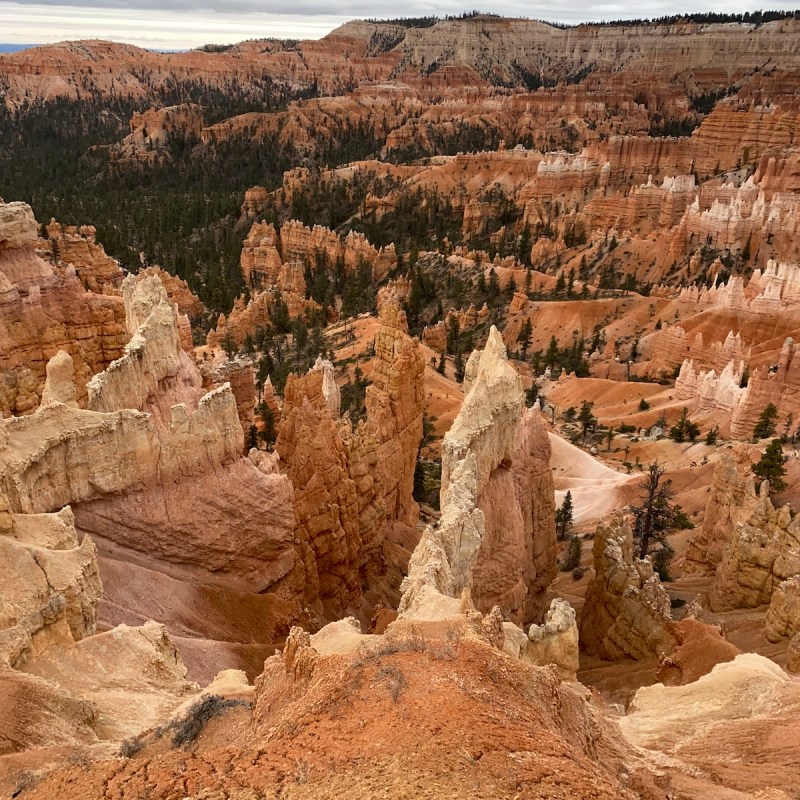
Only 78 miles from Zion National Park is Bryce Canyon National Park, the place to see the largest collections of hoodoos in the world! We recently traveled to Southern Utah to explore both parks, and I can tell you that having these two fantastically unique parks so close together is incredible! Flying into Las Vegas, we drove about 2 hours to St. George, Utah, where stayed for a few days. From St. George, we traveled to Bryce, then onto Zion.
Videos by TravelAwaits
The drive from St. George to Bryce Canyon is about 2.5 hours. You could also fly directly into St. George, Utah rather than driving up the 4 hours from Las Vegas. The St. George Regional Airport is decent sized and is serviced by large carriers like Delta and American. Another option is to fly into Salt Lake City and drive about 4 hours south to Bryce Canyon.
Once you get there, it’s easy to navigate within the park because there is only one entrance, one exit, and one main road that runs north to south. If you’re driving, start at the visitor center and as you travel south, all viewpoints and trailheads will be on the left. Bryce Canyon offers a super convenient shuttle, so you may want to leave your car parked and ride. The shuttle is free with your paid park admission and will take you to the park’s most popular overlooks and trails. If you’re hiking, the shuttle is a great option too, as it makes stops at most trailheads and along Bryce Amphitheater Rim Trail. The shuttle does run seasonally, so if you’re going off-season, check to make sure the shuttle is running.
As far as when to visit, Bryce Canyon, like all the national parks, is busiest in the summer. If you can go outside of summer, both spring and fall are perfect times to visit and those months will be way less crowded. Bryce is open year-round, but many services are closed during the winter months, so keep this fact in mind.

1. Take In The Hoodoos
To take in the spectacular hoodoos (tall, thin rock formations) from above, follow the rim of the Bryce Amphitheater. You’ll be high above the unique rock formations and will enjoy a spectacular view from vantage points along the route. Bryce Canyon even has a fun program in place called Hike The Hoodoos, which is part hiking and part scavenger hunt – a great way to have even more fun on the trails. The most popular views are at Bryce, Inspiration, Sunset, and Sunrise Points. The hike between Sunset and Sunrise Point is flat and paved, so it was not too tough to navigate. That said, hiking boots are still necessary. There’s no way I would venture on any of the trails without them! In fact, the park recommends that everyone use crampons or other traction devices during the winter months because the trails and parking lots can become extremely slippery.

2. Queen’s Garden
For a hike that Bryce Canyon rates as moderately difficult, a lot of people like the 2.9-mile Queen’s Garden/Navajo Combination Loop. Queen’s Garden trail is the least difficult trail descending into the Bryce Amphitheater but it is challenging in spots. This 1-2 hour down and back hike goes to the Queen Victoria hoodoo. Overall, this is a not-too-extreme hike that’s a great way to view the hoodoos up close. Start the hike at either Sunrise or Sunset Point and get ready to see fantastic views!

3. Inspiration Point
Some say this is the best view in the park. We walked the rim trail to Inspiration Point and were blown away by the views. The trail leading up to the point was very steep but worth it. And if you don’t want to go all the way up, you can still get a really good view. You can actually get a decent view from the parking lot, so go as far as you like – you’ll still have a view. And you can access Inspiration Point via shuttle or by car, so no worries if you’re not into hiking. No matter your vantage point, Inspiration Point is impressive, and it’s hard to believe this glorious wonder was created by nature! This was one of our favorite stops in Bryce Canyon. I’d highly recommend a visit here to catch the sunset also. We were told that for the best sunset experience, arrive about an hour and a half before sunset and get ready to take in the nature-made light show.

4. Bryce Canyon Scenic Drive
The scenery is breathtaking all around, and one of the best ways to take it all in is by driving the Bryce Canyon Scenic Drive. This 38-mile round trip scenic drive offers many places to stop and take in the view. If you do the whole thing, the route will take a minimum of 3 hours, and more if you get out and take lots of pictures like we did. Signs mark each overlook and each has a parking lot – but the lots could be full at peak times. It’s a great way to get an overview of Bryce Canyon NP. And you can choose to stop at any or all of the stops along the drive.

A lot of people don’t take the time to drive this beautiful drive. But it’s a great alternative way to see the beauty of the park if you’re not into doing a lot of hiking. And don’t be fooled by the lack of views from the road. Most of the views are down in the canyon so you have to stop at the overlooks to see. The most popular stops are Sunrise Point, Sunset Point, Inspiration Point, Bryce Point, Natural Bridge, Rainbow Point, and Yovimpa Point. My advice is to take your time to appreciate what you see. We were a little rushed because of our itinerary, and I wish we would’ve had more time. I’ll use that as a good reason to go back!

5. Lodge At Bryce Canyon
If you want to stay in the park, check out the Lodge at Bryce Canyon. This historical beauty is actually on the National Historic Register and is well worth your time to visit. Here you’ll find a variety of lodging options including western cabins and motel-style rooms. The lodge itself was designed by famed architect Gilbert Stanley Underwood and was built in the 1920s. The Lodge at Bryce Canyon Lodge is one of many railroad buildings, resorts, and lodges Underwood designed for Union Pacific Railroad in the 1920s.
You can also see his gorgeous design work in lodges at Zion National Park, Grand Canyon, Yellowstone, and Yosemite. You will need to make reservations far in advance if you want to stay here because the lodge is uber-popular and sells out quickly! In addition to lodging, the Bryce Canyon Lodge serves delicious meals in the formal dining room, some with a Western flair like the bison stew, buffalo sirloin, and elk stew. The coffee shop and pizzeria offer more casual cuisine alongside beer, wine, and coffee. There’s also a gift shop onsite and a general store just down the road.

6. Astronomy And Night Sky Programs
Places without light pollution are rare. Bryce Canyon is one of the very few places in the country where you can experience a truly dark sky and view thousands of stars in the night sky. Bryce Canyon even has special park rangers that protect the night sky to ensure it remains preserved for natural darkness. How cool to be able to venture out after dark and see the night sky in a way you’ve probably never seen before. Enjoy this unique experience at Bryce Canyon but make sure you bring a light or headlamp because most areas are darker than expected after sunset. Bryce also has a robust astronomy program. Led by astronomy rangers and volunteers, the programs cover all sorts of astronomy-related themes like the life cycle of stars, constellation stories, and full-moon hikes.

7. Zion-Mount Carmel Highway
Beauty at every turn: That’s how I would describe the Zion-Mount Carmel Highway. If you happen to be visiting both Bryce Canyon and Zion National Park as we did, you’ll want to take the Zion-Mount Carmel Highway that connects the two. The road twists and turns every which way leading to magnificent view after magnificent view. We drove from Bryce Canyon into Zion. If you go this same route or the reverse, be aware that the Zion-Mount Carmel Tunnel is super long and narrow. The tunnel was built beginning in the 1920s when cars were a lot smaller and there weren’t so many big campers. But today we obviously have lots of big cars and campers on the road, so the park has traffic control procedures in place that are used whenever large vehicles need to use the tunnel.
If your vehicle is taller or wider than the limitations, you’ll be required to use the traffic control through the tunnel. This means the park rangers will stop oncoming traffic through the tunnel so you may come down the center of the road in the tunnel. You’ll be charged around $20 per vehicle for using traffic control. Keep in mind that the tunnel is not open 24 hours. The usual closing time is anywhere between 4:30 to 7:00 p.m. depending on the season.
